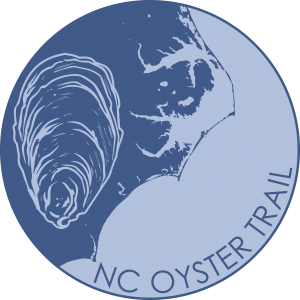Oyster trail designed to protect threatened industry
New trail along North Carolina coastline includes oyster farms, seafood markets, restaurants and educational sites.
by Jodi Helmer on July 25, 2022 | Reprinted from Carolina Public Press

Scott Burrell pilots his barge from Wilmington into the waters at the north tip of Figure Eight Island in North Hanover County. On the approach to the Cape Fear Oyster Co.’s farm, black plastic cages float in the water.
Burrell manages three leased sites in the Intracoastal Waterway that total just under 4 acres where he has the potential to grow up to 4 million oysters a year. He shares the entire process from oyster seed to half shell on guided tours of the farm designed to make North Carolinians more aware of the importance and vulnerability of oysters.
“It’s hard for people to imagine (an oyster farm) until they see it,” he explained.
Cape Fear Oyster Co. is one of the stops on the N.C. Oyster Trail, developed in partnership with the N.C. Coastal Federation, the N.C. Sea Grant and the N.C. Shellfish Growers Association to promote “oyster tourism” on the North Carolina coast.
The trail, launched in 2020, includes oyster farms, seafood markets, restaurants and educational sites in an effort to boost a threatened species.
Saving a species
Wild oyster populations in North Carolina have experienced dramatic declines; the number of harvested bushels dropped from 200,000 in 1960 to just 35,000 in 1994 due to overharvesting, habitat loss, disease and predators.
Although the numbers are on the rise — thanks, in large part to oyster farming — with harvested bushels climbing to 157,000 in 2019, the N.C. Division of Marine Fisheries continues to list them as a species of concern.
Oyster farming reduces the strain on wild oyster populations, allowing them to rebound while catering to local appetites for fresh seafood.

The N.C. Oyster Blueprint, a stakeholder action plan for restoration and protection of oyster populations, calls for “expanded and supported sustainable development of the shellfish aquaculture industry,” which includes increasing the number of oyster farms.
“There’s been substantial growth in the last five years and a big legislative push to fund the industry,” Burrell says.
The COVID-19 pandemic put a hold on those efforts and created significant hardships for oyster farmers. Restaurants closed, causing most oyster farmers to lose their markets. The shellfish weren’t included on the U.S. Department of Agriculture list of specialty crops, making oyster farmers ineligible for federal aid like the Coronavirus Food Assistance Program.
Most of the restaurants on the N.C. Oyster Trail, which spans from Nags Head to Bald Head Island along the coast, closed or pivoted to takeout with limited menus. State mandates prevented farmers from offering tours. With restaurants reopening and restrictions easing, oyster farmers are eager to share their harvests again.
Oyster farmer Roy Emerson believes that farm tours play a huge role in bolstering demand for oysters.
“The more knowledge the public has about what we do, the better it’ll be for the industry,” he said.
“You might complain about how much oysters cost in restaurants, but when you see how many people are involved in getting oysters to the plate, they don’t seem too expensive. The (N.C. Oyster Trail) helps us spread the word.”
Educating the public
Traveling the self-guided trail offers an opportunity for oyster lovers and the oyster-curious to learn more about the North Carolina shellfish industry and meet the farmers.
“People can feel good about eating farmed oysters,” says Beth Darrow, chief scientist at the Bald Head Island Conservancy “Eating an oyster is tasting the flavors of the estuary it was raised in.”

Roysters NC is one of 16 shellfish Farms on the N.C. Oyster Trail. Emerson started farming oysters on a leased site in Beaufort in 2018.
He grows the oysters in floating bags. Water and food flow through the floating bags, which are attached to the ocean bottom with anchors and lines, generating annual harvests of up to 200,000 oysters from the 2-acre farm.
It takes between 10 and 18 months for his oysters to mature. During that time, Emerson takes a boat out to the farm often to check on their progress; he removes mud, chips off wild oysters that have attached to the shells and moves the growing oysters to larger bags to ensure the shellfish are in perfect condition to sell to seafood wholesalers and restaurants.
“We touch them several times before they go to market,” he said. “A lot of people think we put the oysters out, they grow, and we harvest them when they’re ready, but there’s a lot that goes on in between.”
Embracing environmental benefit
The oysters are doing a lot of work, too. Oysters filter algae from the water, with a single oyster filtering up to 50 gallons of water per day, improving water quality. Oyster reefs also provide habitat for other species and protect against storm surge in coastal communities, according to the National Oceanic and Atmospheric Administration.
At Bald Head Island Conservatory, one of the educational sites on the N.C. Oyster Trail, visitors can learn about barrier island environments and the importance of oyster ecology.
The nonprofit environmental education center also leads guided kayaking tours through the marsh to showcase wild oyster reefs, and volunteers can sign up to bag recycled oyster shells for reef restoration or count spat (baby oysters) as part of a citizen science project.
“Understanding something is the first step to protecting it,” Darrow said.
“Most of our visitors aren’t aware of the life cycle of oysters, that they spend time in the plankton or even that the reefs that (people) kayak through are full of living oysters. We support (the N.C. Oyster Trail) even though we are not an oyster-farming operation because we educate the public on the importance of oyster ecology.”
The opportunity to educate the public about oyster farming was one of the reasons Burrell signed on to be part of the N.C. Oyster Trail. He hopes that teaching others about the industry will help it grow.
“The farmers have really banded together to support each other,” he said. “If we harvest wild oysters at the same rate (we’re harvesting farmed oysters), we’ll be overharvesting, and that’ll cause environmental issues.”




